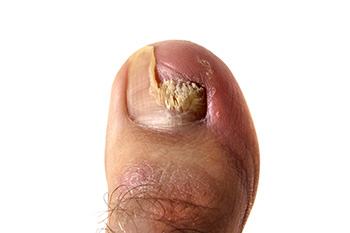
Toenail fungus often starts subtly, with maybe a small yellow spot or thickened edge, but it can quietly progress beneath the nail’s surface, changing how the nail feels and looks. What many overlook is that it is not just a cosmetic issue. The infection weakens the nail structure, making it brittle, misshapen, and difficult to trim, which can lead to discomfort while wearing shoes. For some, it can even affect balance or walking confidence. Current treatments go beyond simple creams, using advanced options like topical solutions that penetrate the nail more effectively. Healthy nail growth takes patience, as nails renew slowly, but consistent care can make a visible difference. If your toenails are discolored, thick, or difficult to manage, it is suggested that you schedule a visit with a podiatrist for an evaluation and personalized treatment.
If left untreated, toenail fungus may spread to other toenails, skin, or even fingernails. If you suspect you have toenail fungus it is important to seek treatment right away. For more information about treatment, contact one of our doctors of Hamilton Foot and Ankle Associates. Our doctors can provide the care you need to keep you pain-free and on your feet.
Symptoms
- Warped or oddly shaped nails
- Yellowish nails
- Loose/separated nail
- Buildup of bits and pieces of nail fragments under the nail
- Brittle, broken, thickened nail
Treatment
If self-care strategies and over-the-counter medications does not help your fungus, your podiatrist may give you a prescription drug instead. Even if you find relief from your toenail fungus symptoms, you may experience a repeat infection in the future.
Prevention
In order to prevent getting toenail fungus in the future, you should always make sure to wash your feet with soap and water. After washing, it is important to dry your feet thoroughly especially in between the toes. When trimming your toenails, be sure to trim straight across instead of in a rounded shape. It is crucial not to cover up discolored nails with nail polish because that will prevent your nail from being able to “breathe”.
In some cases, surgical procedure may be needed to remove the toenail fungus. Consult with your podiatrist about the best treatment options for your case of toenail fungus.
If you have any questions please contact our offices located in Brooklyn, New York, NY . We offer the newest diagnostic and treatment technologies for all your foot and ankle needs.
